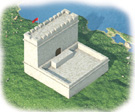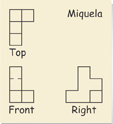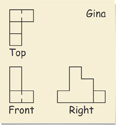-
Error Analysis Miquela and Gina drew orthographic drawings for the cube structure below. Who is correct?
Make an orthographic drawing for each isometric drawing.
-

Image Long Description -

Image Long Description -

Image Long Description -
Fort Use the diagram of the fort below.

- Make an isometric drawing of the fort.
- Make an orthographic drawing of the fort.
-
Aerial Photography Another perspective in aerial photography is the “bird's-eye view,” which shows an object from directly overhead. What type of drawing that you have studied in this lesson is a bird's-eye view?
- Writing Photographs of buildings are typically not taken from a bird's-eye view. Describe a situation in which you would want a photo showing a bird's-eye view.
Visualization Think about how each net can be folded to form a cube. What is the color of the face that will be opposite the red face?
-

-

-

-

-
Multiple Representations There are 11 different nets for a cube. Four of them are shown above.
- Draw the other seven nets.
- Writing Suppose you want to make 100 cubes for an art project. Which of the 11 nets would you use? Explain why.
Table of Contents
- 6-1 The Polygon Angle-Sum Theorems
- 6-2 Properties of Parallelograms
- 6-3 Proving That a Quadrilateral Is a Parallelogram
- 6-4 Properties of Rhombuses, Rectangles, and Squares
- 6-5 Conditions for Rhombuses, Rectangles, and Squares
- 6-6 Trapezoids and Kites
- 6-7 Polygons in the Coordinate Plane
- 6-8 and 6-9 Coordinate Geometry and Coordinate Proofs







